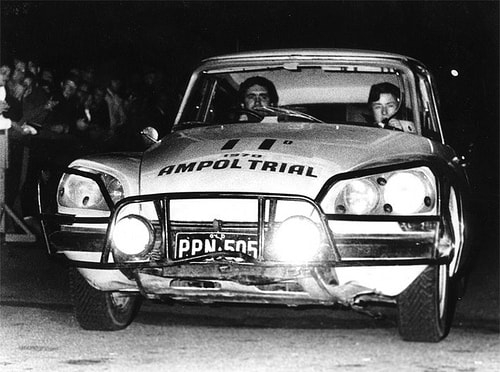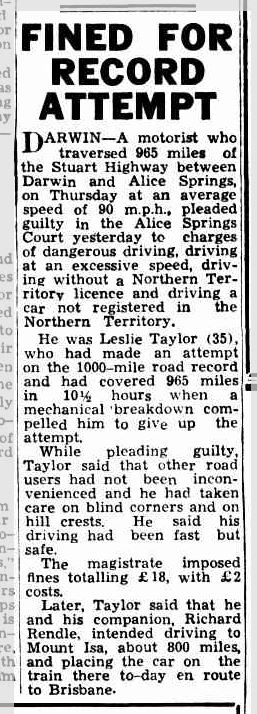Other Australian driving records
1970 Citroen DS21 inter-city records

Motoring writer and racer David McKay wrote briefly in his autobiography about a mid-1970 impromptu record-setting event involving three Citroen DS21's.
The cars were entered in the 1970 Ampol Trial and arrived late by ship in Perth and needed to be transported to the east coast. With an eye to publicity, Ampol suggested that the cars be driven across the country in an attempt to set new inter-city records as a promotion for the upcoming rally.
The cars started at midnight from St George's Terrace, the main street in Perth, with one car destined for Brisbane (Jim Reddiex), one to Melbourne (Eddie Perkins and son Larry) and one to Sydney (David McKay and Graham Watson).
The cars were fitted with extra fuel tanks in Perth (55-litres) but were not yet run in so needed to be kept under 4,000 rpm for the first 800 km of the journey, which was to around Norseman. Even with that limit, the cars were able to cruise at 160 km/h but once run in, 195 km/h was possible.
In 1970, around 640 km of the Nullarbor crossing was on unsealed roads, which McKay described as "damned rough going" although he praised the Citroen for "floating over everything" at only a slightly diminished speed.
McKay wrote that his own crossing to Sydney was uneventful aside from nearly falling into a police trap outside Perth. He said they had time to stop for a shower and food at Ceduna in South Austraia, and lost about half and hour trying to find the Ampol garage in Narrandera NSW in the middle of the night, not wanting to disappoint the dealer who had stayed open for them.
They made it to the Channel 9 studios in Artarmon in Sydney in a little under 30 hours, an average of around 130 km/h. Fuel consumption was 14 l/100 km.
McKay said that it was unhurried excercise, for the Citroen was the most advanced car in the world at the time, with comfort and long legs.
Larry Perkins says that they had no problems in the Melbourne-bound car, and had no issues with the police despite running at 170 km/h much of the way. He also added that his father, Eddie, did all of the driving while Larry slept most of the way.
The time may have been 29 hours although Larry recalls they may have arrived around 7 am, which would be around 31 hours.
The run to Brisbane was completed in 35 hours and 51 minutes, an average speed of 123 km/h over 4,418 km. The same car was later driven to equal first place by Jean-Claude and France Lucette Ogier in the Ampol Trial.
Source: Scuderia Veloce by David McKay (p. 184), Wheels, January 1981 (p. 108), Larry Perkins (April 2021), and Lance Collins (via Stephen Cooke, July 2021).
1951 - Darwin TO Alice Springs - Leslie Taylor

Les Taylor was a 35-year-old Brisbane-based motorcycle dealer and moderately successful motor racing driver. He wanted to break a few driving records and set his sights on a record set in 1949 by Jack "Gelignite" Murray between Darwin and Alice springs of 16 hours, and at the same time beat the highest open road average of 131 km/h set in the 1949 Mille Miglia by Biondetti and Salani. The road between the two centres had been built by the American Army during World War II.
In July 1951 he purchased a brand new Jaguar XK120 and asked his salesman Dick Rendle to join him on the record-breaking trip.
The Jaguar was modified with an extra 135-litre fuel tank with an electric pump to transfer fuel to the main tank.
Later in July the car was transported to Darwin where Les attempted to get permission from the police for the drive and organise official timing. The police did not give their permission but Les did organise for the Air Force to provide accurate, but unofficial, timing. They had planned a practice run but this was scrapped.
After some disappointment at the state of the roads, they set off on the run at 6:30 one morning, hoping to complete it in less than 11 hours.
Throughout the run they sent progress by telegram to Frank Reid back in Brisbane.
The first 320 km was through rolling hill, but they hit a kangaroo in the first 12 minutes and stopped to check for damage.
Back on the road, they built up an average speed of 155 km/h.
Roadside repairs were needed after spinning-out while avoiding wild horses at 145km/h and hitting a bank. They had to straighten steering and suspension parts and replace a wheel and were back on the road in twenty minutes, but with the car shuddering.
They stopped for fuel at Katherine at 9:30 am, faced dangerous storm drains at 195 km/h, and stopped a second time for fuel at Dunmarra at 11:22 am.
By half way, their average was 118 km/h, and they were affected by the heat and mirages. They thought they saw elephants and a woman pushing a pram in front of them.
They stopped again for fuel at Tennant Creek at 1:47 pm.
They got the Jaguar airborn a couple of times, once when hitting a peak at 210 km/h. They had to battle through heards of cows.
At Barrow Creek at 3:!6 pm, their average was well-over 160 km/h.
At one point they encountered a construction crew working on the road and drove through hot liquid tar, which was flung throughout the cabin. They were forced to drive alongside the road for the remainder of the road works.
At 5:02pm they arrived at Alice Springs, for a time of 10 hours and 32 minutes. They were met by cheering spectators, reports and police. Their average speed was 145.89 km/h and fuel consumption was 11 mpg.
Les was questioned by police, taken to jail and released on bail. When he later attended court he received a twenty pound fine.
